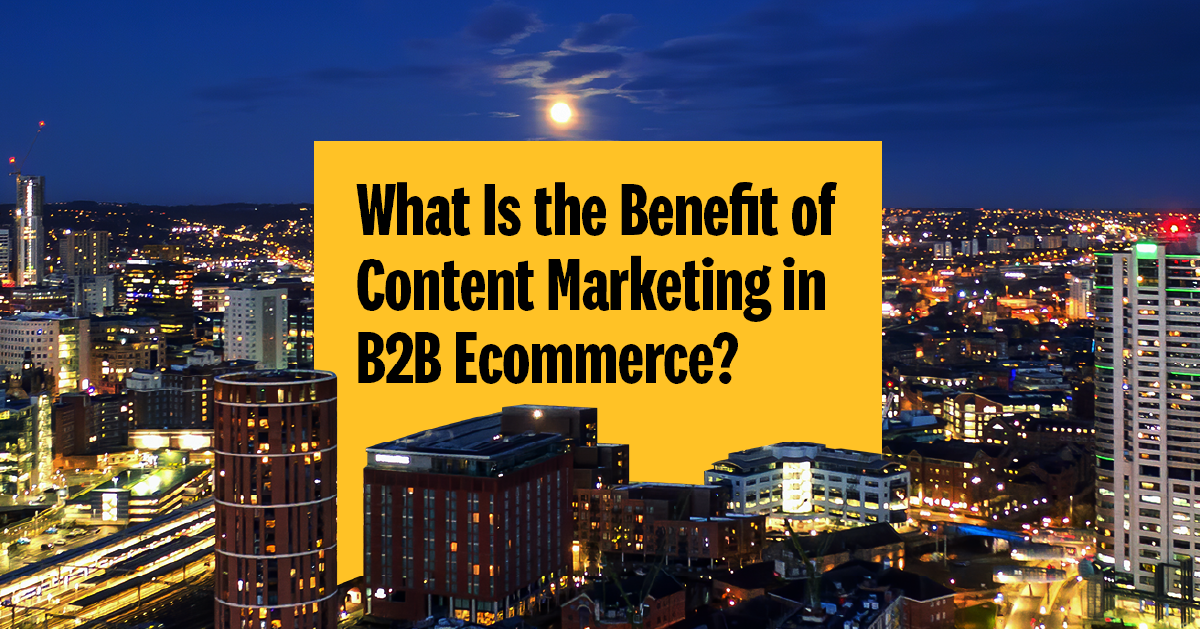What Is the Benefit of Content Marketing in B2B Ecommerce?
What if the trade fair was canceled and the salespeople could no longer go to the customer? How can you still offer customers and prospective customers the best possible advice and support them when making purchases?
B2B companies that mainly rely on traditional sales have faced these issues over the last couple of years. The time for lockdowns may have passed, and face-to-face meetings may be possible again – but there is no turning back time. Most transactions between companies will continue to be carried out digitally.
B2B providers are therefore investing in ecommerce channels, so that they can reach their target groups digitally. But they must offer more than just product catalogs and ordering functions. In the advice-intensive B2B business, ecommerce only works in conjunction with content: as B2B content commerce.
Why is content so important in B2B commerce, and what exactly can it achieve? This article will explain this in detail – and provide five tips for successful content marketing in B2B.
What Is the Role of Content Marketing in B2B Ecommerce?
Content is much more than just advertising to attract the attention of your target groups. In ecommerce, content also takes on the role of customer adviser or salesperson: It provides prospective customers with the required information throughout the entire customer journey: from research to product selection and the decision to buy. Why is content marketing so important in B2B commerce in particular?
Supporting Online Searches and Shopping
As in B2C, purchasers in companies also usually begin their product research online – on Google or in a specialist portal. They only make personal contact with potential suppliers at a late stage in the decision-making process, if at all. Many B2B transactions are completed via online shops entirely without personal contact, and the same applies to SaaS products.
According to Gartner’s ”New B2B Buying Journey”, buying centers (groups of decision-makers) spend 27 percent of their time in the buying process doing online research, and only 17 percent in contact with suppliers.

In the DemandGen 2020 B2B Content Preferences Study 47 percent of the B2B decision-makers surveyed said that they consume three to five content pieces before contacting a provider; 30 percent even consumed more than five content pieces. While 67 percent stated that they rely much more on their own research than just one year ago.
Over the last few years, this development was driven by two main factors: On the one hand, the relocation of all activities to the virtual space during lockdown as a result of the coronavirus pandemic; on the other hand, the growing influence of “digital natives”, who have now taken on decision-maker positions in the economy.
Providers that do not offer any online content or whose content is hard to find, are simply ignored by prospective customers. Meanwhile, providers that offer the best content, with answers to their target groups’ questions, are one step ahead in the selection process.
Covering the Information Requirement for Complex Products
Digitalization and technological progress on the whole mean there is a constant flow of new offerings on the market. These are more efficient than the older offerings, but are also significantly more complex. This means that the need for information when buying these products is growing – and must be satisfied by extensive content.
Addressing an Overall Buying Center
In B2B, decisions to buy are usually taken by several people: the so-called buying center or buying group. The average size of the buying center has grown in recent years. Often, three to five people are involved; even more when it comes to big investments.
Often a provider’s sales team only has contact with individual people from the buying center. The others receive only the information that is forwarded to them or that they themselves research. The better the content made available to the various decision-makers by the provider, the more able the provider is to influence their decision positively.
Supporting long, complex buying journeys
Selection and decision-making processes in the company are often unclear and time-consuming. Tasks migrate to and from between different departments or lie around in between. It is therefore difficult for a provider’s sales department to predict who will require which information for a potential customer and when. However, providers can circulate content for every phase of the B2B customer journey, so that prospective customers can find and use it at any time.
Differentiating Yourself From the Competition
The increasingly complex products are difficult for prospective customers to assess; making it difficult for outsiders to discern the differences between individual providers. That’s why personal sympathy and trust play a big role, even in the apparently rational B2B environment. Customers go wherever they feel safe and well-informed. But how does this feeling come about, if there is no personal contact at all? Providers can differentiate themselves from competitors through content, and show that they best understand and can solve their target groups’ problems.
B2B Ecommerce - Achieve Cross-Team Success With the Right CMS
Find out how you can successfully meet the challenges of modern B2B commerce across teams - with the right CMS.
Which Objectives Can You Achieve Through Content Marketing?
Content marketing is an all-purpose weapon for B2B ecommerce. What objectives can you use it for?
Attracting the Attention of the Target Group
Through regular trade articles and blogs or social media posts, brands keep cropping up in the field of vision of their target groups and can position their messages there. The “mere exposure effect” is scientifically proven: the more often people see something, the more positive their attitude towards it.
When potential customers then actually search for products at some point, they are more likely to remember providers whose content they have seen and consumed more frequently. Search engines are also an important channel for being found. On Google, the providers whose content answers the questions of the target group are positioned at the top.
Generating Leads
Leads – contact details of potential customers – are the raw material from which B2B sales departments acquire new customers. For a long time, new leads were mainly acquired at trade fairs, or they were bought. Due to the fact that the coronavirus pandemic and GDPR have made both of these channels significantly more difficult, B2B companies have primarily turned to online lead generation. Prospective customers have to register with their contact details to receive specialist information. The sales department can then contact the leads and nurture them (”lead nurturing”).
Advising on Purchases
As already mentioned, content takes on the role of a buyer’s guide in ecommerce. Which product will solve my problem? Which technical specifications does it need? Is it compatible with my other solutions? Which model or provider is better for me? All these questions must be answered through content. Through content, customers are able to make better and faster decisions – of benefit to customers and providers alike.
Lowering Sales Costs
If customers prefer to search and shop online, B2B companies should not only see this as a challenge. Producing content once and making it available online is cheaper than having your sales team constantly answer the same questions in person.
With content commerce, B2B providers can automate the majority of their sales processes. They can reduce their costs and use their sales team for the most valuable tasks, such as for supporting key customers.
Lowering Complaint Quotas
When online shoppers return products or make complaints, it’s usually due to a lack of content. For example, customers notice something about the product that wasn’t clear to them during the buying process. By providing detailed information in the online shop, many returns might be avoidable, such as describing the fit for clothing or describing the exact functions or compatibilities in technical products.
Instructions also help buyers to use a product correctly and avoid errors, thus rendering complaints and personal queries to customer service superfluous.
Offering Top Customer Experience
Yet it is not only the provider that stands to gain from the advantages of outstanding content marketing in B2B ecommerce. As already mentioned, customers want to search and shop online – and they need detailed information to do this.
The better providers are able to serve these wishes, the better they help the customers themselves: They have to search less, are better informed, don’t waste time, find exactly the product they are looking for – and they have fun doing it. Content is one of the key factors for the B2B customer experience at every point along the customer journey.
Which Content Is Suitable in B2B Ecommerce?
Content is always relevant. During initial research, for product selection, before making a decision, or after making a purchase; only the objectives differ in each case. Which formats and channels are specifically suitable for which phases or objectives in B2B ecommerce?
Attracting Attention
Blog, SEO
Social media
Online advertising
Classical advertising and PR
Trade fairs, events (online and offline)
Providing (Additional) Support With Product Selection and Buying
White papers, analyst reports, studies
Test reports, product comparisons
Product descriptions, data sheets
Product demos, (virtual) product presentations
Reviews, testimonials, case studies, user reports
Support After the Purchase
Support and knowledge database, FAQ
Usage and repair instructions
Customer magazine, email newsletter
Communities, user groups
Five Tips for Successful B2B Content Commerce
What do you need for successful content marketing in B2B commerce? We have put together five tips for you.
1. Thought Leadership Content
Content only offers a competitive advantage if it is better than that offered by competitors. Don’t simply repeat what everyone else is writing. Instead, generate thought leadership content and present something genuinely new. Have your CEO write about a future trend, interview experts, implement your own study, or explain an issue from an entirely new perspective.
2. Content Repurposing
Producing and circulating content is expensive – especially when it comes to complicated B2B issues. A frequent mistake is only using content once for a campaign or in one place, and continuously producing new content on the same issues.
Instead, you should reuse content as often as possible and produce content pieces in different formats; this method is called content repurposing. This will reduce production costs and enable you to create new content or campaigns much faster.
The prerequisite for content repurposing is a content hub. All of your content is stored centrally in it and all individual assets can be found and reused easily.
3. Omnichannel Marketing
Not only should you use your content several times, but you should also present it on as many channels as possible: For example, don't only show product information in the online shop, but also in your sales app and on external B2B provider and product comparison portals.
Your content hub comes into play again here too, in conjunction with a headless CMS. This allows you to play your content on practically unlimited numbers of digital channels and operate omnichannel commerce.
4. Content Curation
It is hard for customers to find their way through the mass of content and obtain the information that is actually useful for them. To establish yourself as an expert in a particular subject area, you may not need to produce any of your own content (or at least not so much).
Instead, you can operate content curation: You compile content from various sources and prepare it for your target groups in an easily consumable way, such as in a regular newsletter.
5. Entertainment Factor
For a long time, B2B content was synonymous with dry, technical content. But B2B buyers are people who also enjoy watching YouTube or TikTok videos and like to have fun while they work.
Even if your subjects are dry and technical, you should not bore or annoy your potential customers by circulating hard to consume and plain content to them. At least make your content look nice and clear. And if you manage to entertain your target groups slightly to boot, mission accomplished!










